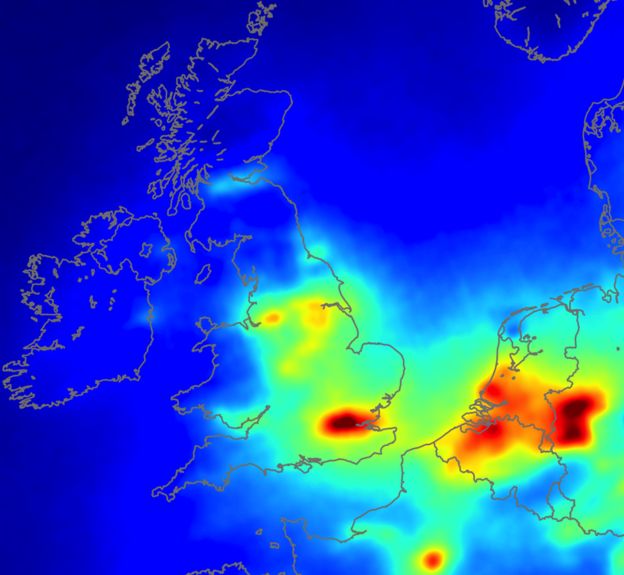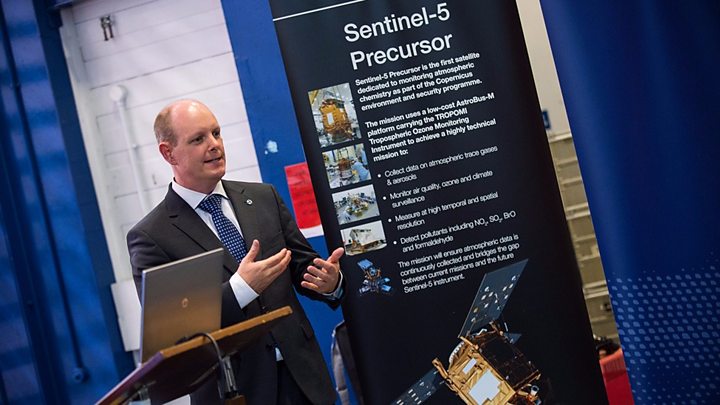21.07.2017
UK wants continued EU Copernicus participation
 Image copyrightAIRBUS DS/MAX ALEXANDER
Image copyrightAIRBUS DS/MAX ALEXANDER
The UK has given the clearest statement yet of its desire to stay within the European Union's Copernicus Earth observation programme after Brexit.
EU member states are building the most advanced ever satellite system for monitoring the state of the planet - with Britain playing a major role.
Business Secretary Greg Clark says he wants that participation to continue.
His comments came as Airbus UK debuted the latest satellite for Copernicus known as Sentinel-5 Precursor.
This spacecraft will make global maps of gases and particles in the atmosphere to track pollution and climate change. It is set to launch on a Russian rocket in September.
"The UK-built Sentinel-5 Precursor satellite and the success of the Copernicus Programme demonstrates what we can achieve through collaboration with our European partners and the UK's vital role in the programme thanks to our Earth observation expertise," Mr Clark said.
"We've been clear that we want our companies and universities to continue participating in key EU space programmes, and through our Industrial Strategy and ongoing investment in the UK space sector, we are ensuring we have the infrastructure and skills in place to support our ambition to capture 10% of the global space market by 2030."

What is the Copernicus programme?
- EU project that is being procured with European Space Agency help
- Pulls together all Earth-monitoring data, from space and the ground
- Will use a range of spacecraft - some already up there, others yet to fly
- Expected to be invaluable to scientists studying climate change
- Important for disaster response - earthquakes, floods, fires etc
- Data will also help design and enforce EU policies: fishing quotas etc
The government's pre-election White Paper on Brexit stated that the UK would like to collaborate with the EU-27 on science and space beyond March 2019 - but the language from minsters on Copernicus specifically has recently become much sharper.
Science minister Jo Johnson said something very similar to Mr Clark last weekwhen he announced a £100m investment in a satellite-testing facility in Oxfordshire.
Continued participation in Copernicus will, of course, be subject to negotiation with the remaining EU nations; but key UK government departments - such as Business, Defra and the MoD - are understood to be pushing hard for that participation to be maintained.
Copernicus is by some distance the most ambitious EO development under way anywhere in the world at the moment.
The general public tends to think that America leads on all things space, but the US does not have a civil EO plan to match what is going on in Europe right now.
Copernicus envisages a whole suite of spacecraft sensors in orbit to take the pulse of Planet Earth.
Five of these Sentinels - as the satellites are all called - have already been launched. 5P is the next to go up. More still will follow.
The multi-billion-euro project is led - and 70% funded - by the European Commission. The other 30% comes from the European Space Agency (Esa), which acts as the technical and procurement agent on the programme.
And although Britain will be leaving EU membership behind in just under two years, its membership of Esa - an international organisation that is a separate legal entity - will continue. That adds an extra layer of complexity into the Brexit process. But Graham Turnock, the chief executive of the UK Space Agency, said that skills, jobs and science would all benefit from Britain continuing to play a full role in Copernicus.
"There is a clear statement of intent," he told reporters. "Obviously, it will need to be worked through as part of the broader discussions around our exit from the European Union but we don't want industry to be in any sense unsure of our direction of travel."
 Image copyrightOMI/KNMI
Image copyrightOMI/KNMI
Airbus UK and other British space companies believe their expertise puts them in a strong position to win more Copernicus business. There will be many tens of Copernicus contracts up for grabs in the next two to three years - some of them very large indeed.
Sentinel-5P is the result of a €45.5m (£40m) contract that was signed in 2011. The satellite carries a single sensor known as TROPOMI, which has been produced by a Dutch consortium, led scientifically by the KNMI (Royal Netherlands Meteorological Institute).
This instrument is a four-in-one spectrometer that is capable of distinguishing a range of chemical species in the atmosphere that are associated with pollution. These include nitrogen dioxide and sulphur dioxide, which are emissions from fossil-fuel burning.
TROPOMI will also monitor ozone - both the "good" version of the gas that sits high in the atmosphere and protects us from harmful ultraviolet radiation; and the "bad" ozone that forms at ground level and causes respiratory irritation in vulnerable individuals.
The Copernicus Sentinel series of satellites
- Sentinel-1: Radar satellite that can see the Earth's surface in all weathers
- Sentinel-2: Multi-wavelength detectors to study principally land changes
- Sentinel-3: Similar to S2, but tuned to observe ocean properties and behaviour
- Sentinel-4: High-orbiting sensor to measure atmospheric gases
- Sentinel-5: Low-orbiting atmospheric sensor to help monitor air quality
- Sentinel-6: Future version of the long-running Jason sea-surface height series
The "Precursor" in the spacecraft's name references the fact that the instrument comes before a near-identical sensor that will eventually fly on Europe's next-generation weather satellites from 2021.
Putting up 5P now also ensures there is no data gap in observations should an ageing, previous-generation instrument suddenly fail. That sensor, called OMI, flies on the US space agency's Aura satellite. Although still in good health, it is operating far beyond its design lifetime.
"But TROPOMI is more than a gap-filler because it will see a major improvement in data quality," said principal investigator Pepijn Veefkind from KNMI.
"The spatial resolution is 10 times higher than OMI. It will be like putting on glasses; you will be able to distinguish different regions of a city to see how they change as emissions evolve," he told BBC News.
Josef Aschbacher, the director of Earth observation programmes at Esa, said Sentinel-5P would be feeding an insatiable demand for EO data.
Already, Copernicus was servicing tens of thousands of users across the world, he added: "Per day, we produce more data from our satellites than Facebook is accumulating through videos and photos uploaded by millions or billions of people on its site."
Quelle: BBC

